These fine items were apparently inlaid in a couch-throne placed in a palatial structure • The discovery, unearthed in excavations by the Israel Antiquities Authority and Tel Aviv University in the Givati Parking Lot in the City of David in the Jerusalem Walls National Park, sheds new light on the power and importance of Jerusalem at the time of the Judahite Kingdom • The items will be displayed for the first time at the 23rd Conference of the City of David Studies of Ancient Jerusalem
An extraordinary discovery was unearthed in Jerusalem: an assemblage of ivory plaques from the First Temple period, among the few found anywhere in the world, and the first of their kind to be found in Jerusalem. They came to light in the excavations of the Israel Antiquities Authority and Tel Aviv University at the Givati Parking Lot in the City of David in the Jerusalem Walls National Park; the excavations are funded by the City of David Foundation. The ivories, considered one of the costliest raw materials in the ancient world – even more than gold – were found among the ruins of a palatial building in use when Jerusalem was at the height of its power (the eighth and seventh centuries BCE). Scholars believe that the decorated ivories were inlaid in wooden furnishings that were used by the residents of the building – people of means, influence and power, possibly high government officials or priests. The ivories will be on display next Tuesday, September 13th, at the 23rd Conference of the City of David Studies of Ancient Jerusalem. They will also be displayed in October at the Jerusalem Conference of the Israel Antiquities Authority, Tel Aviv University and the Hebrew University.
 |
| Part of the ivory assemblage that was uncovered - contained no less than 1500 fragments. Photo Eliyahu Yanai: City of David |
According to the excavation directors, Prof. Yuval Gadot of Tel Aviv University’s Department of Archaeology and Near Eastern Cultures and Dr. Yiftah Shalev of the Israel Antiquities Authority: “To date, we only knew of decorated ivories from the capitals of the great kingdoms in the First Temple period, such as Nimrud, the capital of Assyria, or Samaria, the capital of the Israelite Kingdom. Now, for the first time, Jerusalem joins these capitals. We were already aware of Jerusalem’s importance and centrality in the region in the First Temple period, but the new finds illustrate how important it was and places it in the same league as the capitals of Assyria and Israel. The discovery of the ivories is a step forward in understanding the political and economic status of the city as part of global administration and economy.”
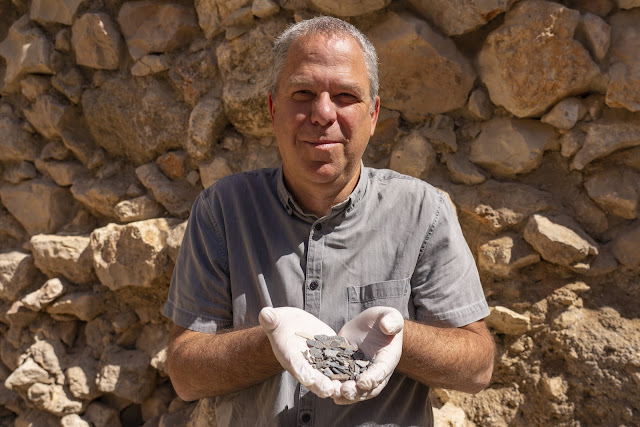 |
| Prof. Yuval Gadot holds pieces of ivory decorations, hundreds of which were found in the excavation. Photo: Yaniv Berman, Antiquities Authority |
Ivory is mentioned only a few times in the Bible, always in connection with royalty or great wealth – the description of the throne of King Solomon (I Kings 10:18); an ivory palace built by King Ahab in Samaria (1 Kings 22:39); and the prophet Amos’ castigation of Israelite nobility: “They lie on ivory beds, lolling on their couches” (Amos 6:4).
The impressive building in which the ivories were unearthed was devastated in a huge fire, apparently during the Babylonian destruction of Jerusalem in 586 BCE, and the ivories were discovered smashed into tiny pieces and burnt. During the excavation, as part of the wet-sieving project in Emek Tsurim National Park, no fewer than 1,500 fragments were found. It was only after a unique restoration project, led by conservator Orna Cohen, together with Ilan Naor from the Israel Antiquities Authority, that the plaques were restored, and the richness of the assemblage was revealed. “At the end of the process of joining and ‘fusing’ hundreds of the fragments, we were able to understand that the assemblage includes remnants of at least 12 small square plaques – about 5 cm x 5 cm, at most 0.5 cm thick – which were originally inlaid in wooden furnishings,” Cohen and Naor said.
 |
| Dr. Yeftah Shalev holding the ivory inlays. Photo: Yaniv Berman, Antiquities Authority |
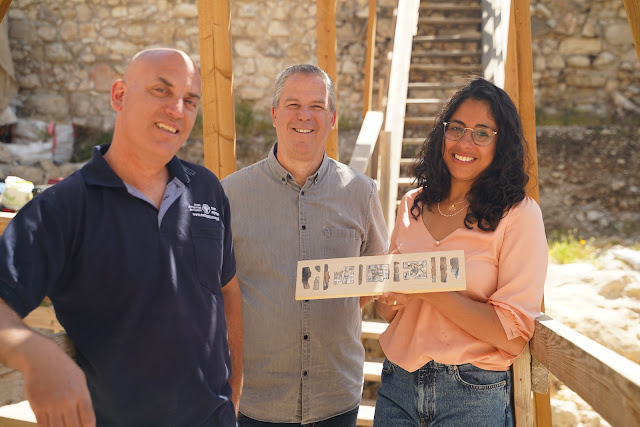 |
| From right to left: Reli Avisher, Prof. Yuval Gadot and Dr. Yeftah Shalu with the rare find. Photo: Gil Mazoman, City of David |
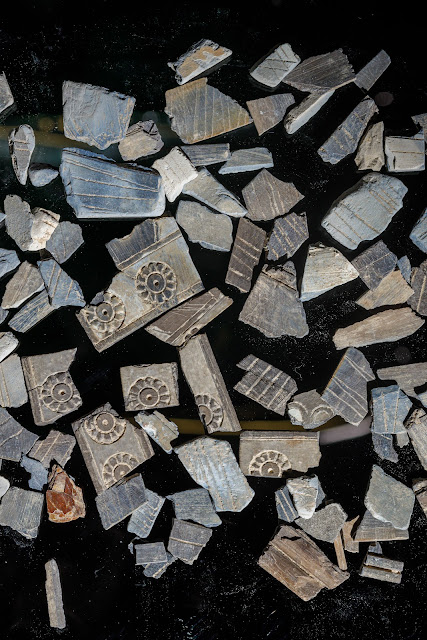 |
Part of the ivory assemblage that was uncovered - contained no less than 1500 fragments. Photo Eliyahu Yanai: City of David
|
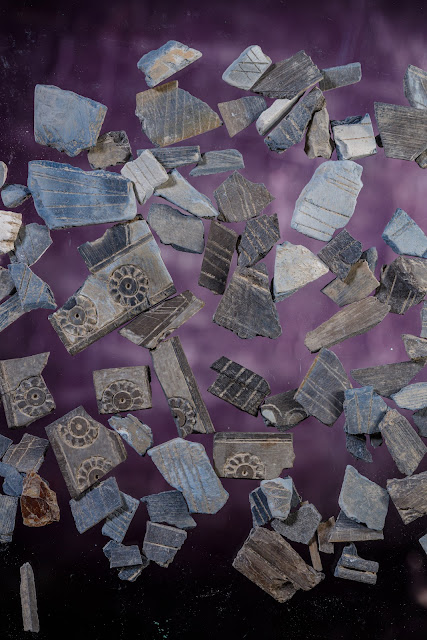 |
| Part of the ivory assemblage that was uncovered - contained no less than 1500 fragments. Photo Eliyahu Yanai: City of David |
The ivories that were discovered were not the only prestigious items found at the site. A seal made of agate (a semi-precious stone) was also unearthed, as well as a seal impression carrying the name “Natan-Melech servant of the king”, jars that had held vanilla-spiced wine, decorated stone items and wooden objects that were apparently part of other large wooden furnishings.
Decorated ivories are the rarest and most outstanding finds in archaeological assemblages. Their prestige stems from the source of the ivory: microscopic testing by Harel Shohat of the University of Haifa revealed that they were made from elephant tusk.
“The prestige of ivory is also associated with the great skill required to work with it and create decorations,” Prof. Gadot and Dr. Shalev explain. “The assemblage of ivory discovered in the City of David was probably imported, and originally made by artisans from Assyria. The ivories may have come to Jerusalem as a gift from Assyria to Jerusalem’s nobility. Following a comparison with complete objects that appear on wall plaques from the palace of the Assyrian King Sennacherib at Nineveh, we suggest that the ivory plaques from Jerusalem were originally inlaid in a couch-throne, and we may imagine that it had been situated on the second floor of the opulent structure.”
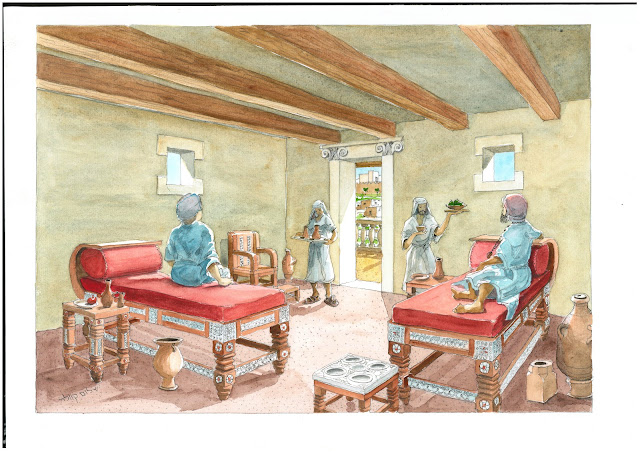 |
Illustration of the inlay of the ivories in the throne beds. Credit: Shalom Kevlar, City of David
|
 |
The ivories Photo by Dafna Gazit, Israel Antiquities Authority
|
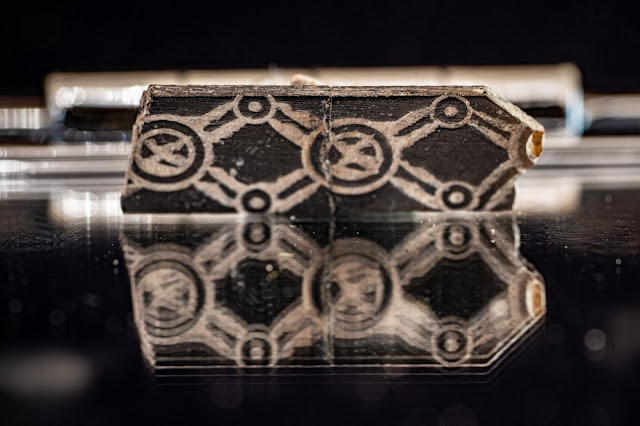 |
A piece of ivory that was burned in the destruction of the First Temple. Photo: Gil Mazoman, City of David
|
 |
Assembling the ivories into shape in the Antiquities Authority laboratories. Photo: Dafna Gazit, Antiquities Authority
|
The decorations on most of the ivories were the same, consisting of frames incised with rosettes in the center of which was a stylized tree. Other plaques were adorned with lotus flowers and a geometric pattern. According to Dr. Ido Koch and Reli Avisar of Tel Aviv University, who studied the objects, the rosette and the tree were popular symbols in the Mesopotamian visual repertoire and in other cultural centers. Ivory objects with similar decorations were discovered in the assemblage of ivories from Samaria, and in more distant palaces, such as Nimrud and Khorsabad in the heart of the Assyrian Empire. The Judahite elite adopted these symbols during the time that Judah was under the rule of the Assyrian Empire (beginning in the second half of the eighth century BCE).
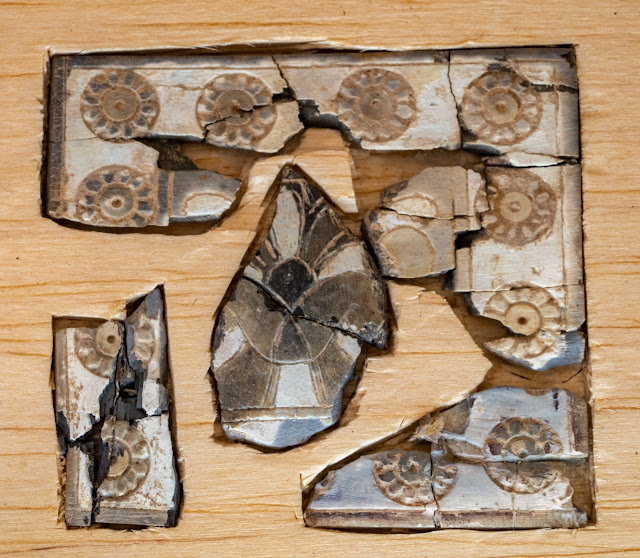 |
A frame with engraved roses and a stylized tree in the center. Photo: Gil Mazoman, City of David
|
 |
A frame with engraved roses and a stylized tree in the center. Photo: Eliyahu Yanai, City of David
|
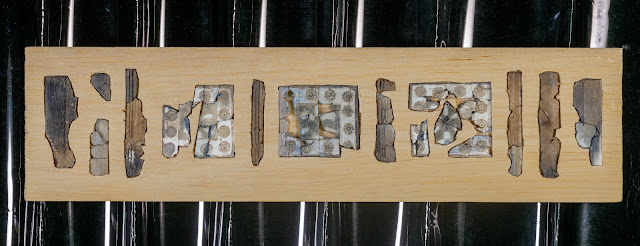 |
| The ivories were inserted into a piece of furniture - possibly a throne bed that stood in the magnificent building. Photo: Eliyahu Yanai City of David |
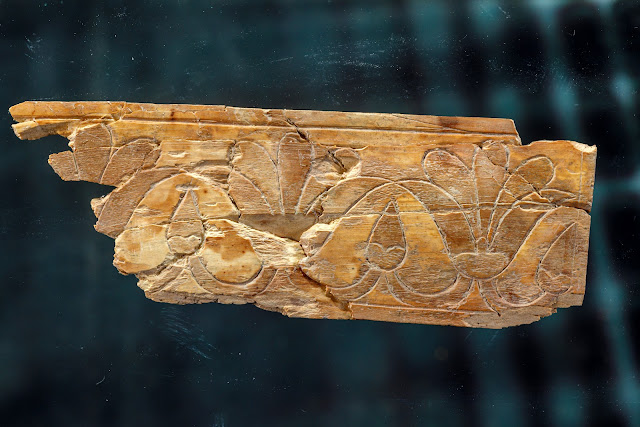 |
An ivory plate decorated with the lotus flower. Photo: Eliyahu Yanai, City of David
|
Interestingly, these three symbols appeared at that time in Judah as symbols of the kingdom both on stone items that adorned opulent buildings (decorated stone capitals discovered in Jerusalem at Armon HaNatziv, at Ramat Rachel and Nahal Rephaim, as well as seals used in the royal administration (rosette seals were used to stamp jars, marking their contents as belonging to the royal household). Even more interesting is the fact that the animal and human mythological figures that appear on ivory items discovered in Samaria, Nimrud and other centers do not exist in the Jerusalem assemblage. “I possible that what we have here is evidence of a cultural choice by the Jerusalem elite as to which
global symbols to adopt and which to reject,” the scholars say
|
|
| Relli Abrahami from Tel Aviv University with an ivory plaque decorated with the lotus flower. Photo: Yaniv Berman, Antiquities Authority |
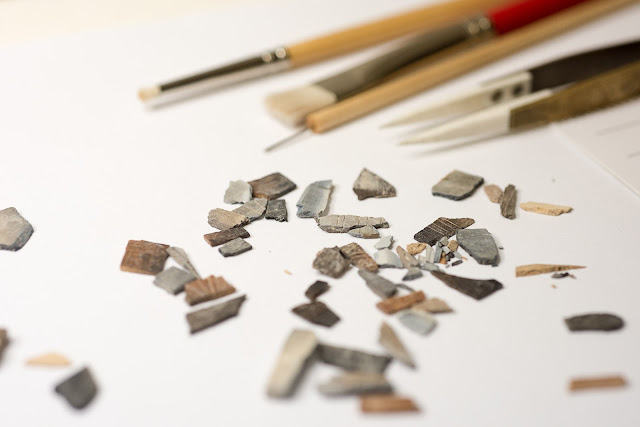 |
| The ivories before the conservation treatment. Photo: Dafna Gazit, Antiquities Authority |
Eli Eskozido, director of the Israel Antiquities Authority, said: “The excavations in the City of David never stop surprising us. This time, with the help of the delicate and inspiring work of conservators and researchers, we have been given a glimpse into the daily life of the people who lived here thousands of years ago. These discoveries breathe life into the ancient stones. The realization that the material culture of the social elites in Jerusalem in the First Temple period did not fall short of – and perhaps even exceeded – that of the other ruling centers in the Ancient Near East, demonstrates the status and importance of Jerusalem at that time.”
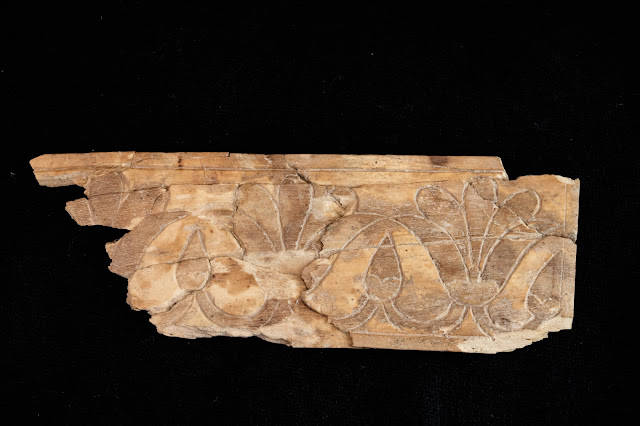 |
| An ivory plate decorated with the lotus flower. Photo: Gil Mazoman, City of David |
 |
| An ivory plate decorated with the lotus flower. Photo: Yaniv Berman, Antiquities Authority |
 |
| The ivories were inserted into a piece of furniture - possibly a throne bed that stood in the magnificent building. Photo: Yaniv Berman, Antiquities Authority |





















